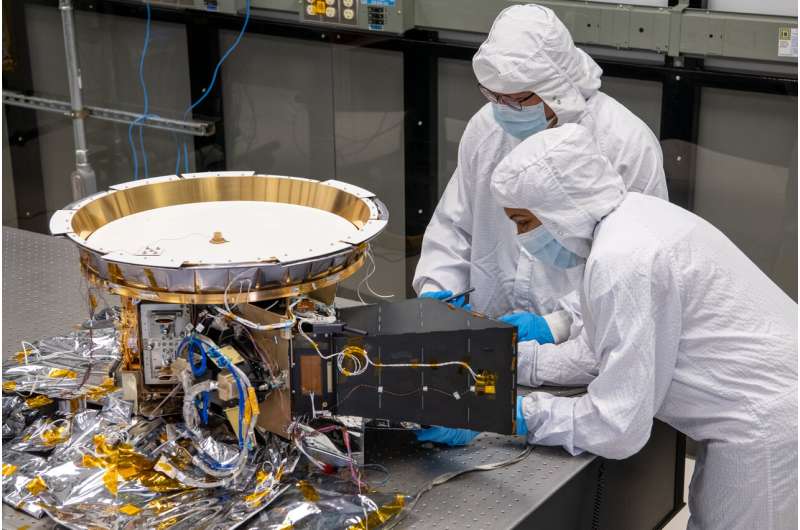The spacecraft, which will be the first to explore the Trojan asteroids—a population of small bodies that share an orbit with Jupiter—-is in the final stages of the assembly process. Just five months ago, at the beginning of the Assembly, Testing and Launch operations (ATLO) process, the components of the Lucy spacecraft were being built all over the country. Today, a nearly assembled spacecraft sits in the high bay in Lockheed Martin Space in Littleton, Colorado.
"A bit over a year and a half ago, I was excited to hold the first small pieces of metal that were destined to travel to the Trojan asteroids," says Hal Levison, principal investigator from the Southwest Research Institute. "Now there is an actual spacecraft, nearly ready to go. It is incredible."
The final instrument, L'Ralph, was built by NASA's Goddard Space Center in Greenbelt, Maryland and was received at Lockheed Martin on January 21 and integrated on to the spacecraft on January 26. L'Ralph is the most complicated instrument that will fly on Lucy, as it is actually two instruments in one. The Multispectral Visible Imaging Camera (MVIC), will take visible light color images of the Trojan asteroids. The Linear Etalon Imaging Spectral Array (LEISA), will collect infrared spectra of the asteroids. Both of these components will work together to allow Lucy to determine the composition of the Trojan asteroids and provide insight into the early history of our solar system.
The L'Ralph instrument experienced significant COVID-19 related delays, particularly when construction had to be halted when Goddard was placed under stage 4 COVID restrictions in April of last year. However, both the L'Ralph team at Goddard and the ATLO team at Lockheed Martin rose to the challenge and developed a new schedule that allowed everyone to work safely while keeping the spacecraft on track for its originally planned October 16, 2021 launch.
"The L'Ralph team has done an outstanding job to deliver a fantastic instrument," says Dennis Reuter, L'Ralph instrument principal investigator, from Goddard. "Doing what they did under normal conditions would have been remarkable. Doing it under the actual conditions that had to be dealt with is amazing."
L'Ralph has been installed on Lucy's Instrument Pointing Platform. This platform provides the spacecraft significant flexibility during the encounters—-the instruments can point at the Trojan asteroids during the high-speed flybys while the high gain antenna remains pointed at Earth—-as well as carrying out fine adjustments and out-of-plane pointing to get the best data possible on these elusive objects.
Lucy's other two scientific instruments, L'TES and L'LORRI, designed and built at Arizona State University, and Johns Hopkins Applied Physics Laboratory, respectively, as well as the two Terminal Tracking Cameras have already been installed on the platform. Now that L'Ralph is installed, the platform itself will be installed onto the spacecraft bus—making Lucy one step closer to ready for her 12-year-long journey to the Trojans.
"Lucy ATLO has been tremendously successful and having L'Ralph delivered and integrated onto the Instrument Pointing Platform is a great start to the new year," said Donya Douglas-Bradshaw, mission project manager from Goddard.
Explore further



